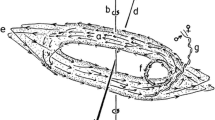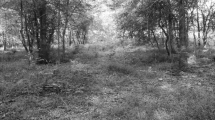Abstract
The swarming and mating behaviour ofChironomus flaviplumus was observed and compared with a sympatric congeneric species,C. yoshimatsui. C. flaviplumus males swarmed around sunset near foliage or angles of buildings near the emergence site and copulated with females entering the swarm. Swarming and mating occurred under conditions of higher light intensity in cooler seasons than in warmer ones. Results suggested that temperature had an effect on the timing of flight to the swarming site in both sexes. TheC. flaviplumus swarm marker and swarming behaviour seemed very similar to that toC. yoshimatsui, and their respective daily swarming time zone greatly overlapped. No mixed swarm, however, was observed in the study area. This is probably due to the distance between the species' larval habitats. Possible premating isolation mechanisms between these 2 species are discussed.
Similar content being viewed by others
References
Chiba, Y. 1967a Activity of mosquitoes,Culex pipiens pallens andAedes japonicus, under a step-wise decrease of light-intensity.Sci. Rep. Tohoku Univ., Ser IV (Biol.) 33: 7–13.
Chiba, Y. 1967b Observations on swarming habit of the mosquito,Culex pipiens pallens.Sci. Rep. Tohoku Univ., Ser. IV (Biol.) 33: 15–28.
Chiba, Y., M. Kubota & Y. Nakamura 1982 Differential effects of temperature upon evening and morning peaks in the circadian activity of mosquitoes,Culex pipiens pallens andC. pipiens molestus.J. interdiscipl. Cycle Res. 13: 55–60.
Downes, J. A. 1969 The swarming and mating flight of Diptera.Ann. Rev. Entomol. 14: 271–298.
Hardeland, R. 1972 Species differences in the diurnal rhythmicity of courtship behaviour with-in themelanogaster group of the genusDrosophila.Anim. Behav. 20: 170–174.
Heimbach, F. 1978 Sympatric species,Clunio marinus Hal. andC. balticus n. sp. (Dipt. Chironomidae), isolated by differences in diel emergence time.Oecologia (Berl.) 32: 195–202.
Kon, M. 1984 Swarming and mating ofChironomus yoshimatsui (Diptera: Chironomidae): Seasonal change in the timing of swarming and mating.J. Ethol. 2: 37–45.
Kon, M. 1985 Activity patterns ofChironomus yoshimatsui (Diptera: Chironomidae). I. Effects of temperature conditions on the adult activity patterns.J. Ethol. 3: 131–134.
Kon, M. 1987 The mating system of chironomid midges (Diptera: Chironomidae): A review.Mem. Fac. Sci., Kyoto Univ. (Ser. Biol.) 12: 129–134.
Lindeberg, B. 1964 The swarming of males as a unit for taxonomic recognition in the Chironomidae (Diptera).Ann. Zool. Fenn. 1: 72–76.
Mielbradt, J. & D. Neumann 1976 Reproduktive Isolation durch optische Schwarmmarken bei den sympatrischenChironomus thummi undCh. piger.Behaviour 58: 272–297.
Nielsen, H. T. & E. T. Nielsen 1962 Swarming of mosquitoes. Laboratory experiments under controlled conditions.Entomol. exp. appl. 5: 14–32.
Reisen, W. K., Y. Aslam & T. Swiddiqui 1977 Observations on the swarming and mating of some Pakistan mosquitoes in nature.Ann. Entomol. Soc. Am. 70: 988–995.
Reisen, W. K., M. M. Milby, R. P. Meyer & C. Reeves 1983 Population ecology ofCulex tarsalis (Diptera: Culicidae) in a foothill environment in Kern Country, California: Temporal changes in male relative abundance and swarming behaviour.Ann. Entomol. Soc. Am. 76: 809–815.
Römer, F. & S. Rosin 1971 Einfluss von Licht und Temperatur auf die Schwarmzeit vonChironomus plumosus L. im Jahresverlauf.Rev. Suisse Zool. 78: 851–867.
Sasa, M. 1978 A comparative study of adults and immature stages of nine Japanese species of the genusChironomus (Diptera, Chironomidae).Res. Rep. Nat. Inst. Environ. Stud. 3: 1–63.
Sasa, M. & M. Yamamoto 1977 A checklist of chironomidae recorded from Japan.Jpn. J. Sanit. Zool. 28: 301–318.
Sullivan, W. F. 1981 Insect swarming and mating.Florida Entomol. 64: 44–65.
Syrjämäki, J. 1966 Dusk swarming ofChironomus pseudothummi.Ann. Zool. Fenn. 3: 20–28.
Truman, J. W. 1973 Temperature sensitive programming of silkmoth flight clock: a mechanism for adapting to the seasons.Science 182: 727–729.
Yamamoto, M. 1983 Morphological differences betweenChironomus yoshimatsui andC. flaviplumus (Diptera, Chironomidae).Makunagi: 15–20. (In Japanese)
Author information
Authors and Affiliations
About this article
Cite this article
Kon, M. Swarming and mating behaviour ofChironomus flaviplumus (Diptera: Chironomidae), compared with a sympatric congeneric species,C. yoshimatsui . J. Ethol. 7, 125–131 (1989). https://doi.org/10.1007/BF02350034
Received:
Accepted:
Issue Date:
DOI: https://doi.org/10.1007/BF02350034




